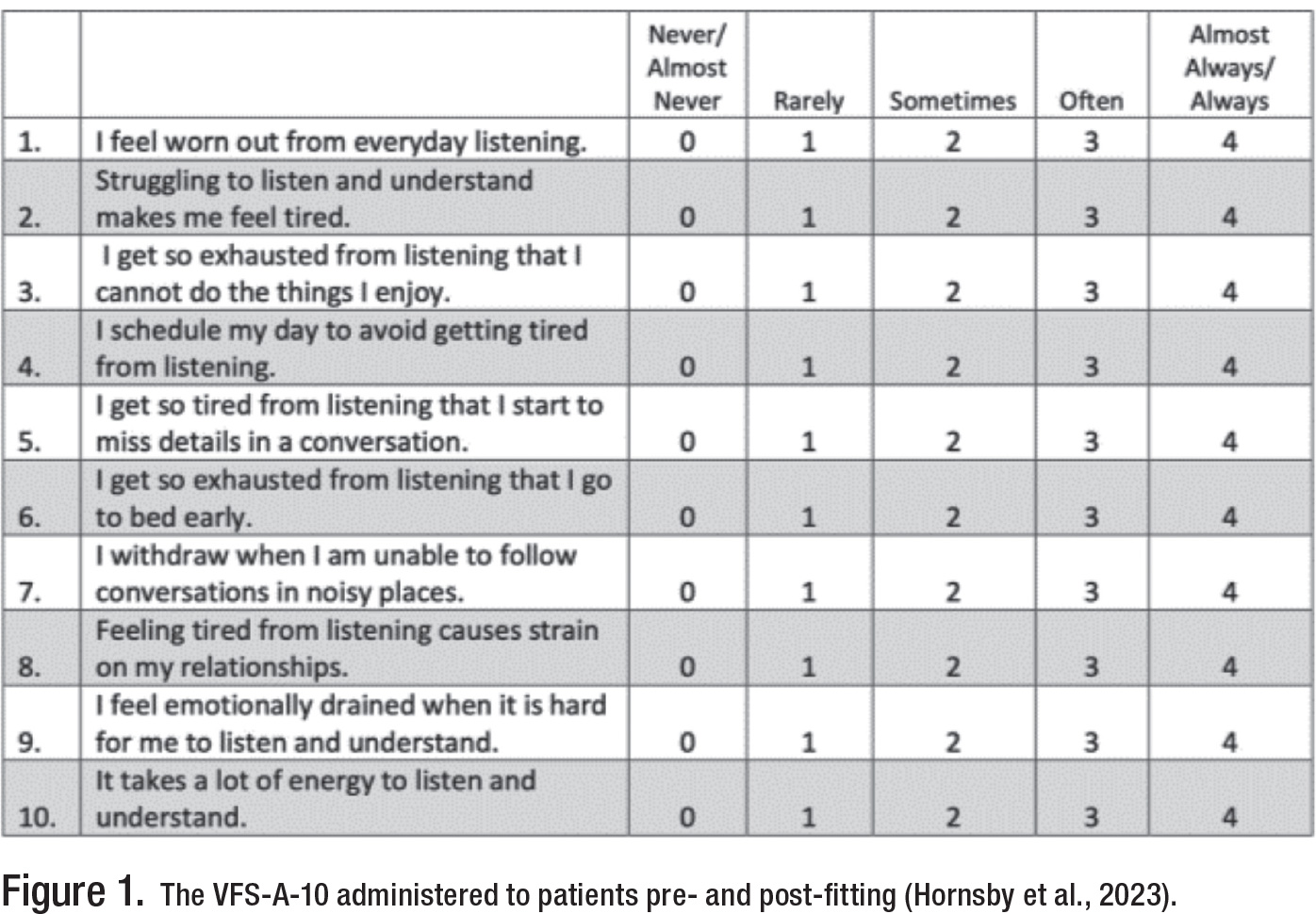
Measuring Listening Related Fatigue with the VFS-A-10
Brian Taylor, Au.D.
Spend a few weeks in a busy hearing aid dispensing practice and it’s just about guaranteed that you will have several patients state that various settings, such as long meetings, conferences, or environments with continuous background noise cause them to feel tired and often extremely exhausted at the end of the day. What patients are describing is a type of mental and physical exhaustion that occurs from prolonged or intense listening, called listening-related fatigue.
Recent research has shown that listening-related fatigue is linked to people being less productive at work, more prone to accidents, more socially isolated, and more likely to be depressed. Symptoms of listening-related fatigue may include difficulty concentrating, irritability, headache, or a sense of mental exhaustion. Additionally, this research indicates older people and persons with hearing loss are more likely to suffer from listening-related fatigue. No wonder so many individuals seeking the help of audiologists complain they are so worn out at the end of a long day of listening.
Although we have known about the ill-effects of listening-related fatigue on persons with hearing loss, it was not possible to readily assess it in the clinic – until now. Benjamin Hornsby and colleagues recently created the Vanderbilt Fatigue Scale for Adults (VFS-A- 10). And there is additional good news: hearing aids can reduce listening-related fatigue.
The VFS-A-10 is a ten-question self-report that assesses several dimensions of listeningrelated fatigue. It can be administered pre and posting fitting. The VFS-A-10 is scored by summing the responses from the five-point Likert scale. It takes less than two minutes for most patients to complete it.
Given the brevity of the VFS-A-10, it can be used as a counseling tool, even when the unaided score is innocuously low.
Simply stated, the higher the tallied score, the more self-reported problems the individual has with listening-related fatigue. According to the originators of the VFS-A-10, a score of 26 or higher is an indication of “frequent problems with fatigue” (Hornsby, et al 2023). A recent clinical study showed that five of 42 (12%) individuals fitted with hearing had a score of 26 or higher, and two of 42 (5%) had a score greater than 30 (Tagvaei & Taylor, 2024). In this study, the mean unaided score was 13, while the mean aided score with 6. This finding demonstrates the benefits of hearing aids at reducing listening-related fatigue.
Symptoms of listening-related fatigue may include difficulty concentrating, irritability, headache, or a sense of mental exhaustion.

Given the brevity of the VFS-A-10, it can be used as a counseling tool, even when the unaided score is innocuously low. For example, let’s say an individual has an unaided overall score on the VFS-A-10 of eight but the patient circled a “4” on Question 7, “I withdraw when I am unable to follow conversations in noisy places.” Even though the other scores were “0’s” and “1’s”, the high score on Question 7 would serve as an area to target for improvement with hearing aids. This high score on just one question of the VFS-A-10 could be addressed through counseling, prior to hearing aid use.
The VFS-A-10: As Easy as 1-2-3
Since the VFS-A-10 can be administered in two minutes or less, has been validated, and measures a common problem that can be alleviated with hearing aids, it is highly recommended for routine clinical use. The VFS-A-10 can be used in the following ways.
- Have each patient complete it in the reception area prior to their initial appointment. Review the results during the initial appointment.
- Re-administer it 2 to 4 weeks post fitting to assess aided benefit in listening-related fatigue. As a general rule, the aided score should be about half of the unaided score.
- Even when the overall aided VFS-A-10 score is low, high scores on individual questions can be identified for improvement with hearing aids and items that can be targeted for counseling. ■
References
- Holman, J. A., Drummond, A., & Naylor, G. (2021). Hearing Aids Reduce Daily-Life Fatigue and Increase Social Activity: A Longitudinal Study. Trends in Hearing, 25, 23312165211052786.
- Hornsby, B. W. Y., Camarata, S., Cho, S.-J., Davis, H., McGarrigle, R., & Bess, F. H. (2021). Development and validation of the Vanderbilt fatigue scale for adults (VFS-A). PSYCHOLOGICAL ASSESSMENT, 33(8), 777–788.
- Hornsby, B. W. Y., Camarata, S., Cho, S.-J., Davis, H., McGarrigle, R., & Bess, F. H. (2023). Development and validation of a brief version of the Vanderbilt fatigue scale for adults: The VFS-A-10. Hornsby BWY, Camarata S, Cho SJ et Al (2023) Development and Validation of a Brief Version of the Vanderbilt Fatigue Scale for Adults: The VFS-A-10. Ear and Hearing. Accepted for Publication. https://doi.org/10.1097/ AUD.0000000000001369
- Tagvaei, N. & Taylor, B. (2023). Clinical Application of the Vanderbilt Fatigue Scale for Adults (VFS-A-10): Feasibility and Ease of Use in a Dispensing Practice. Poster presented at the annual meeting of the American Academy of Audiology. Atlanta, GA.
